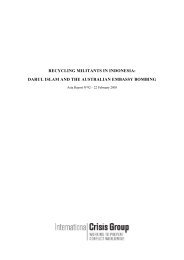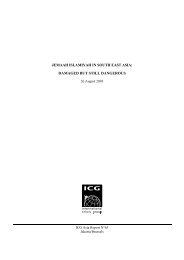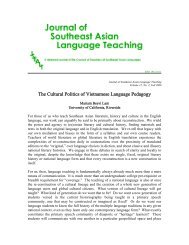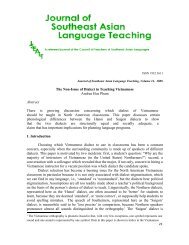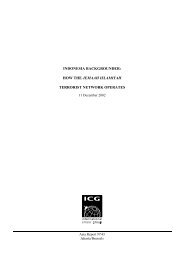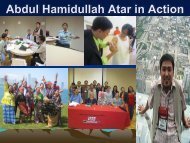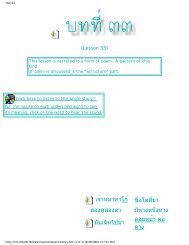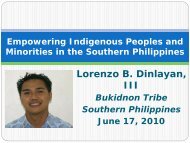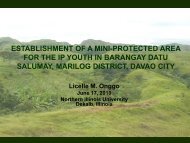Introduction - SEAsite - Northern Illinois University
Introduction - SEAsite - Northern Illinois University
Introduction - SEAsite - Northern Illinois University
Create successful ePaper yourself
Turn your PDF publications into a flip-book with our unique Google optimized e-Paper software.
Prentation Abstracts<br />
Thongsa Sayavongkhamdy<br />
Recent Archaeological Research in Lao PDR<br />
Ph.D.Candidate, Archaeology and Anthropology, Australian National <strong>University</strong>,<br />
Australia<br />
My presentation will try to bring information to these three questions:<br />
1. How the archaeological research is organised in Lao PDR?<br />
2. What is the recent archaeological research?<br />
3. What are the perspectives of archaeological research in Lao PDR?<br />
1. For the first question, the mandate of the Department of Museums and<br />
Archaeology (DMA), Ministry of Information and Culture (MIC) will be briefly<br />
presented. The DMA is the leading governmental organization that deals with four<br />
inter-related issues: 1. Creation and development of museums; 2. Protection of<br />
national antiquities; 3. Conservation of national cultural heritage and 4. the archaeological<br />
research. Policy, legislation, organization and programmes will be<br />
briefed.<br />
2. The recent archaeological research will briefly present the results from<br />
survey and excavation that have been conducted at these sites: 1. Tam Hua Pu<br />
(LPB Province), Tam Nang An (LPB Prov), Plain of Jars (Xieng Khuang Prov),<br />
Lao Pako (Vientiane Prov), Megalithic stones of Muong Hua Muong (Hua Pan<br />
Prov), Tam Hang (Hua Pan Prov), Pu Bia (Saysomboun Special Zone), Xepon<br />
(Savannakhet Prov) and Phe Phen of Nam Theun 2 Hydroelectric Project (Khammuane<br />
and Bolikhamsay Prov).<br />
3. The concerns for the future are of double fold: firstly the national capacity<br />
building and lastly the current trends of thematic research, in particular the matters<br />
that would bring light to the birth of an agriculturalist society in Southeast<br />
Asia. This theme is related to the peopling of the region and more specifically the<br />
migrational movements of the human expansion within the Asian continent.<br />
Loes Schenk-Sandbergen Ph.D<br />
Gender, Land Rights and Culture in Laos: A Study in Vientiane,<br />
Districts, Villages and Households<br />
Department Sociology/Anthropology, <strong>University</strong> of Amsterdam, The Netherlands<br />
Laos is going through a rural transition phase of transforming co-operative,<br />
communal and traditional land tenure ship to individual land ‘ownership’ and use.<br />
In provinces and districts large-scale land surveys were carried out in 1994 and<br />
1995 in order to issue Land Certificates and Land Tax Bills.<br />
The data we (my counterparts and I) collected in 1994 on these operation,<br />
in particular in the rice-growing villages along the Mekong, raised our profound<br />
concern as we found that the whole approach and practice was very male-dominant.<br />
As a result of a combination of gender aspects, it was found that although<br />
land is inherited by women, the name put in land documents was mostly in the<br />
name of ‘the head of the household’: for the majority the men. We warned that the<br />
largest threat for the undermining of the relatively high status of the majority of<br />
Lao women might be located in the sphere of ‘land legislation’. We insisted that<br />
awareness raising and action should be taken immediately to safeguard the land<br />
rights of women in Laos and to prevent drastic negative effects at all levels of the<br />
society. We envisaged that with the male-dominated land registration women may<br />
lose, as experience in other Third World countries shows, one of the most basic<br />
and vital power resources: the land they have inherited from their parents. This in<br />
view of the fact that Laos is one of the very few countries left in the world in which<br />
bi-lineal descent and kinship, matrilocal post marriage residence-, and matrilineal<br />
inheritance patterns still exist for a large group of women.<br />
As a preparation on the adjudication of land ‘ownership’ and land use in<br />
four provinces, a small Pilot Land Title Project was launched in 1996-1997 in two<br />
districts in Vientiane Municipality and in districts of the capitals of four provinces:<br />
Vientiane, Luang Prabang, Savannakhet, and Champasak, and in Vientiane Prefecture.<br />
With the above considerations in mind, and within the context of the pilot<br />
phase, the Australian Agency for International Development and the World Bank<br />
agreed that a study on ‘Land, Gender and Social Issues’ would be useful to examine<br />
multi ethnic, and socio cultural aspects related to land titling. We conducted<br />
the study in 1997 in a participatory way to involve the implementing responsible<br />
staff of the Ministry of Land and Housing, the Lao Women’s Union and NGO<br />
members. In total 10 districts were selected in Vientiane Municipality and in the<br />
four provinces of the pilot land titling and in each district two villages. In each village<br />
women from eight households were interviewed. Interviews were conducted<br />
with district- and village heads and authorities, with women’s focus groups at the<br />
village level (total 221 respondents) and women at the household level (160). My<br />
paper will show the participatory methodology, theoretical concepts and findings<br />
of the study. Moreover, we searched for evidence to explore if the world-wide<br />
‘defeat’ of women-friendly societies is also happening in Laos, or, if there are<br />
indications for a mild process of Lao Lumisation.<br />
Anouvong Sethathirath IV<br />
Looking From the Past into the Future of Lan Xang<br />
Independent Researcher, North Carolina<br />
During the war with Rama III of Siam, King Sethathirath III instructed his<br />
surviving son, Prince Rajsavong, to carry on the Sethathirath line and to guard the<br />
royal treasures. As his father’s command, Prince Ratsavong married his cousin,<br />
begot a son whom he name “Syharath” and continued the struggle for the autonomy<br />
of Laos. One hundred seventy six years after the war of 1827-1829, his<br />
descendents are still working to help Laotians come to term with their history and<br />
to work with neighboring countries for the greater good of the nation of Laos.<br />
The presentation will touch on four main areas: (1) the Buddhist White<br />
Robed Monks and the Sethathirath, (2) The Sethathirath Royal Treasures, (3) Lao-<br />
Issara and my Grandfather, and (4) the Future of Laos.<br />
Bruce P. Shoemaker and Ian G. Baird*<br />
Aiding or Abetting? Village Relocation and International<br />
Donors in the Lao PDR<br />
A number of programs and policies currently in place in the Lao PDR are<br />
promoting the internal resettlement of mostly indigenous ethnic communities<br />
from the more remote highlands to lowland areas and along roads. These ongoing<br />
initiatives--including village consolidation and relocation, and the establishment<br />
of “focal zones”--are often linked to policies calling for the rapid elimination of<br />
swidden agriculture and opium cultivation, and the concentration of rural populations.<br />
International donors--bilateral and multilateral agencies as well as NGOs—<br />
have played a key role in facilitating these initiatives—sometimes intentionally<br />
and other times with little understanding of the issues or the implications of their<br />
support.<br />
There is increasing evidence –throughout the Lao PDR--that internal resettlement<br />
is having devastating impacts on the livelihoods and well-being of<br />
upland people and communities. While usually undertaken in the name of “poverty<br />
alleviation”, these initiatives often, in fact, contribute to long-term poverty,<br />
environmental degradation, cultural alienation, and increasing social conflicts.<br />
The serious impacts of internal resettlement in Laos were first reported in a 1997<br />
UNESCO/OSTROM study which detailed mortality rates of up to 30% in upland<br />
communities following poorly implemented relocations. Since then, evidence has<br />
continued to mount of the negative consequences of internal resettlement. Both<br />
official Lao government documents and a series of more recent studies in many<br />
parts of the country have confirmed many of these same severe impacts.<br />
These studies and reports have affected a number of international donors—some<br />
now say they will not knowingly support internal relocation and will<br />
encourage local government agencies to support more appropriate development<br />
in existing upland communities. This in turn has had some impact on government<br />
agencies. However, other donors claim to distinguish between “voluntary”<br />
resettlement (which they will support) and “involuntary” resettlement (which they<br />
claim not to support).<br />
Recent research calls into question this whole framework. Much of what is<br />
classified as voluntary resettlement is, in reality, not villager-initiated. Most donors<br />
lack the capacity to adequately assess what is voluntary and what is not. Others<br />
remain oblivious or uninterested in the issue. Even when it is brought to their<br />
attention, some agencies appear more concerned about program continuation and<br />
supporting other objectives sought by some western countries—such as an end to<br />
opium cultivation. Are these agencies in reality facilitating violations of the basic<br />
rights of impacted communities through their support for internal resettlement?<br />
In order to avoid this possibility, aid groups need to take a much more analytical,<br />
pro-active and “preventive” approach to their rural development work in<br />
Laos. Some recommendations for doing this are provided, while acknowledging<br />
that local circumstances are likely to dictate somewhat varying approaches in different<br />
areas.<br />
* Bruce Shoemaker is an independent researcher based in Minneapolis who previously worked in Laos for almost<br />
eight years. Ian Baird is a graduate student at the <strong>University</strong> of British Columbia and has worked in Laos<br />
for many years. Both speak Lao, Baird also speaks Brao, an important ethnic language of southern Laos.






